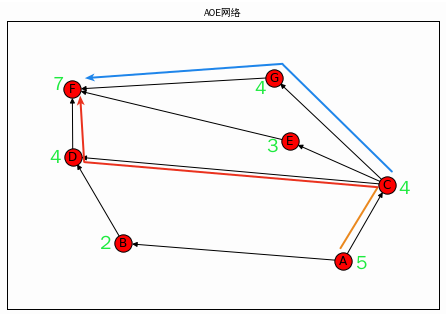NetworkX系列教程(10)-算法之三:关键路径问题
2024-08-27 12:05:30
小书匠Graph图论
重头戏部分来了,写到这里我感觉得仔细认真点了,可能在NetworkX中,实现某些算法就一句话的事,但是这个算法是做什么的,用在什么地方,原理是怎么样的,不清除,所以,我决定先把图论中常用算法弄个明白在写这部分.
图论常用算法看我的博客:
下面我将使用NetworkX实现上面的算法,建议不清楚的部分打开两篇博客对照理解.
我将图论的经典问题及常用算法的总结写在下面两篇博客中:
图论---问题篇
图论---算法篇
目录:
* 11.3关键路径算法(CPA)
注意:如果代码出现找不库,请返回第一个教程,把库文件导入.
11.3关键路径算法(CPA)
以下代码从这里复制,由于版本问题,将代码中的:nx.topological_sort(self, reverse=True)改为list(reversed(list(nx.topological_sort(self))))
- import networkx as nx
- import matplotlib.pyplot as plt
- from matplotlib.font_manager import *
- #定义自定义字体,文件名从1.b查看系统中文字体中来
- myfont = FontProperties(fname='/usr/share/fonts/truetype/wqy/wqy-zenhei.ttc')
- #解决负号'-'显示为方块的问题
- matplotlib.rcParams['axes.unicode_minus']=False
- class CPM(nx.DiGraph):
- def __init__(self):
- super().__init__()
- self._dirty = True
- self._critical_path_length = -1
- self._criticalPath = None
- def add_node(self, *args, **kwargs):
- self._dirty = True
- super().add_node(*args, **kwargs)
- def add_nodes_from(self, *args, **kwargs):
- self._dirty = True
- super().add_nodes_from(*args, **kwargs)
- def add_edge(self, *args): # , **kwargs):
- self._dirty = True
- super().add_edge(*args) # , **kwargs)
- def add_edges_from(self, *args, **kwargs):
- self._dirty = True
- super().add_edges_from(*args, **kwargs)
- def remove_node(self, *args, **kwargs):
- self._dirty = True
- super().remove_node(*args, **kwargs)
- def remove_nodes_from(self, *args, **kwargs):
- self._dirty = True
- super().remove_nodes_from(*args, **kwargs)
- def remove_edge(self, *args): # , **kwargs):
- self._dirty = True
- super().remove_edge(*args) # , **kwargs)
- def remove_edges_from(self, *args, **kwargs):
- self._dirty = True
- super().remove_edges_from(*args, **kwargs)
- #根据前向拓扑排序算弧的最早发生时间
- def _forward(self):
- for n in nx.topological_sort(self):
- es = max([self.node[j]['EF'] for j in self.predecessors(n)], default=0)
- self.add_node(n, ES=es, EF=es + self.node[n]['duration'])
- #根据前向拓扑排序算弧的最迟发生时间
- def _backward(self):
- #for n in nx.topological_sort(self, reverse=True):
- for n in list(reversed(list(nx.topological_sort(self)))):
- lf = min([self.node[j]['LS'] for j in self.successors(n)], default=self._critical_path_length)
- self.add_node(n, LS=lf - self.node[n]['duration'], LF=lf)
- #最早发生时间=最迟发生时间,则判断该节点为关键路径上的关键活动
- def _compute_critical_path(self):
- graph = set()
- for n in self:
- if self.node[n]['EF'] == self.node[n]['LF']:
- graph.add(n)
- self._criticalPath = self.subgraph(graph)
- @property
- def critical_path_length(self):
- if self._dirty:
- self._update()
- return self._critical_path_length
- @property
- def critical_path(self):
- if self._dirty:
- self._update()
- return sorted(self._criticalPath, key=lambda x: self.node[x]['ES'])
- def _update(self):
- self._forward()
- self._critical_path_length = max(nx.get_node_attributes(self, 'EF').values())
- self._backward()
- self._compute_critical_path()
- self._dirty = False
- if __name__ == "__main__":
- #构建graph
- G = CPM()
- G.add_node('A', duration=5)
- G.add_node('B', duration=2)
- G.add_node('C', duration=4)
- G.add_node('D', duration=4)
- G.add_node('E', duration=3)
- G.add_node('F', duration=7)
- G.add_node('G', duration=4)
- G.add_edges_from([
- ('A', 'B'),
- ('A', 'C'),
- ('C','D'),
- ('C','E'),
- ('C','G'),
- ('B','D'),
- ('D','F'),
- ('E','F'),
- ('G','F'),
- ])
- #显示graph
- nx.draw_spring(G,with_labels=True)
- plt.title('AOE网络',fontproperties=myfont)
- plt.axis('on')
- plt.xticks([])
- plt.yticks([])
- plt.show()
- print('关键活动为:')
- print(G.critical_path_length, G.critical_path)
- G.add_node('D', duration=2)
- print('\n修改D活动持续时间4为2后的关键活动为:')
- print(G.critical_path_length, G.critical_path)

关键路径示例(该图非黑色线为手工绘制,数字手工添加)
从graph中可以知道,有两条关键路径,分别是:A->C->G->F和A->C->D->F,长度都是20.
输出:
关键活动为: 20 ['A', 'C', 'D', 'G', 'F']
修改D活动持续时间4为2后的关键活动为: 20 ['A', 'C', 'G', 'F']
关键活动为: ['A', 'C', 'D', 'G', 'F'],可以构成两条边.D活动持续时间4为2后,关键路径变化.
最新文章
- ElasticSearch 配置详解
- Spring MVC学习笔记——POJO和DispatcherServlet
- 1 、Linux-Rhel6终端介绍-Shell提示符
- CSS3之firefox&safari背景渐变之争 - [前端技术][转]
- go lang学习笔记——channel机理及调度理解
- IOS公司开发者账号申请详细教程
- JQuery向ashx提交中文参数方案
- 【JS】Advanced1:Object-Oriented Code
- Qt写的截图软件包含源代码和可执行程序
- rk3288 ov8858 camera移植
- mysql 查看mysql版本的四种方法
- JS - 循环添加 DropDownList(Select)
- 经常使用git命令集
- 用Chrome开发者工具做JavaScript性能分析
- zepto学习之路--数组去重和原生reduce
- [翻译]QT core wallet manual 狗狗币核心钱包使用教程
- 2019/4/22 kmp模板
- HttpServerUtility常用方法
- 高可用Hadoop平台-运行MapReduce程序
- Shell脚本开发规范